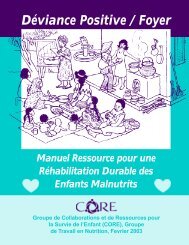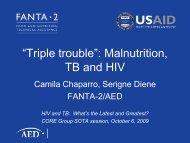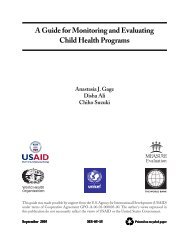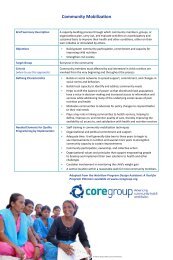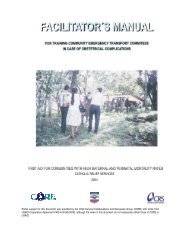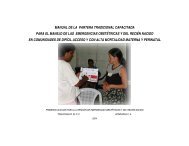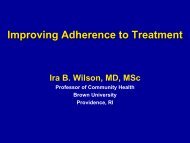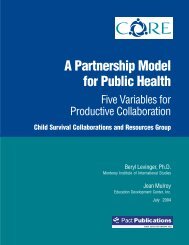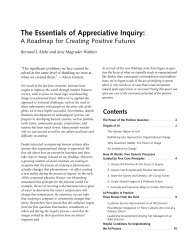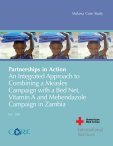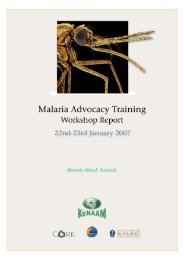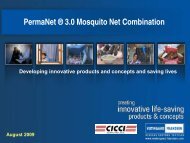Community Approaches to Child Health in Malawi: - CORE Group
Community Approaches to Child Health in Malawi: - CORE Group
Community Approaches to Child Health in Malawi: - CORE Group
You also want an ePaper? Increase the reach of your titles
YUMPU automatically turns print PDFs into web optimized ePapers that Google loves.
III. Programm<strong>in</strong>g with the C-IMCI Framework<br />
In programm<strong>in</strong>g for C-IMCI, World Relief decided the Care <strong>Group</strong> model<br />
was appropriate and needed <strong>in</strong> <strong>Malawi</strong>, and would likely be a success based<br />
on its application <strong>in</strong> other countries. World Relief staff reasoned that Care<br />
<strong>Group</strong>s could sufficiently address the gap created by a limited number of<br />
government health workers at the community level; extend the reach of the<br />
government health system; <strong>in</strong>crease community engagement with the health<br />
system; and help <strong>in</strong>dividual households adopt effective health promotion<br />
practices.<br />
Program staff therefore chose <strong>to</strong> first emphasize Element 3 of the C-IMCI<br />
framework, which would leverage the Care <strong>Group</strong> model <strong>to</strong> focus on<br />
promotion of key family health practices. Emphasis on Element 3 also<br />
corresponds with World Relief’s prioritization of underserved areas where<br />
<strong>in</strong>terpersonal channels for health <strong>in</strong>formation are weak.<br />
Staff also used the C-IMCI framework <strong>to</strong> assess other parts of the health<br />
system, <strong>in</strong>clud<strong>in</strong>g the quality of facility and private sec<strong>to</strong>r services, along<br />
with their accessibility and will<strong>in</strong>gness <strong>to</strong> work with local communities.<br />
Application of the framework’s other three elements naturally followed after<br />
Element 3 mechanisms were <strong>in</strong> place.<br />
1.<br />
Element 3: Integrat<strong>in</strong>g promotion of key family health practices<br />
The practices of parents and other caretakers of young children at the<br />
household and community levels are addressed <strong>in</strong> Element 3. Promotion<br />
of practices critical for child health and nutrition has long been the<br />
corners<strong>to</strong>ne of child health programs. The task fac<strong>in</strong>g C-IMCI is not how<br />
<strong>to</strong> implement s<strong>in</strong>gle <strong>in</strong>terventions or program components such as oral<br />
rehydration therapy promotion, immunization or promotion of exclusive<br />
breastfeed<strong>in</strong>g, but how a program can promote a whole range of key family<br />
practices without sacrific<strong>in</strong>g the effective characteristics of the s<strong>in</strong>gle<br />
<strong>in</strong>tervention-focused programs. 4<br />
If C-IMCI is <strong>to</strong> be effective and susta<strong>in</strong>able, communities need <strong>to</strong> be<br />
empowered <strong>to</strong> take responsibility for their own health. This means that<br />
communities must develop a sense of ownership over the key practices, and<br />
assume the responsibility for practic<strong>in</strong>g and promot<strong>in</strong>g them over the long<br />
term. Participa<strong>to</strong>ry research methods and community-based moni<strong>to</strong>r<strong>in</strong>g and<br />
evaluation efforts are important <strong>to</strong>ols for communities <strong>to</strong> learn about and<br />
assume responsibility for these behaviors.<br />
4 Ibid.<br />
6 <strong>Community</strong> <strong>Approaches</strong> <strong>to</strong> <strong>Child</strong> <strong>Health</strong> <strong>in</strong> <strong>Malawi</strong>



